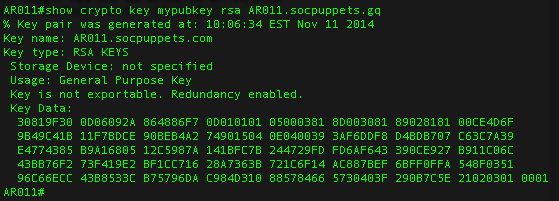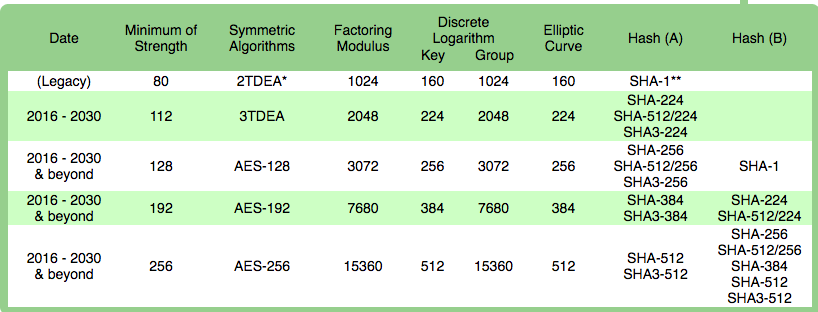Rsa Key Pair Generation Time
- Rsa Key Generation Windows
- Rsa Key Pair Generation Time Definition
- Rsa Key Pair Generation Time Magazine
- Rsa Key Pairs
- Rsa Key Pair Generation Time Formula
While Encrypting a File with a Password from the Command Line using OpenSSLis very useful in its own right, the real power of the OpenSSL library is itsability to support the use of public key cryptograph for encrypting orvalidating data in an unattended manner (where the password is not required toencrypt) is done with public keys.
That generates a 2048-bit RSA key pair, encrypts them with a password you provide and writes them to a file. You need to next extract the public key file. You will use this, for instance, on your web server to encrypt content so that it can only be read with the private key. Generate a key file from crt. Export the RSA Public Key to a File. This is a command that is. Part 1: Selecting a Key Size for Your Root Certificate Server in Windows Server 2012 AD CS. Part 2: Selecting a Cryptographic Key Provider in Windows Server 2012 AD CS. In this post, we’ll look Continue reading How Long Does It Take to Generate an Asymmetric Cryptography Key Pair? If you don't already have an SSH key, you must generate a new SSH key.If you're unsure whether you already have an SSH key, check for existing keys. If you don't want to reenter your passphrase every time you use your SSH key, you can add your key to the SSH agent, which manages your SSH keys and remembers your passphrase.
- This document describes how I generate 2048-bit RSA keys. Here is the log to generate signature key and encryption subkey. I invoke GnuPG with -gen-key option.
- $begingroup$ With the latest change it seems that changes in the RSA key pair generation algorithm itself have less focus. Just a reminder: if e.g. The algorithm for finding primes is altered or enhanced then the RSA key pair generation may also result in a different key pair.
- $ ssh-keygen -t rsa -b 4096 -C 'youremail@example.com' This creates a new ssh key, using the provided email as a label. Generating public/private rsa key pair. When you're prompted to 'Enter a file in which to save the key,' press Enter. This accepts the default file location.
The Commands to Run
Generate a 2048 bit RSA Key
You can generate a public and private RSA key pair like this:
openssl genrsa -des3 -out private.pem 2048
That generates a 2048-bit RSA key pair, encrypts them with a password you provideand writes them to a file. You need to next extract the public key file. You willuse this, for instance, on your web server to encrypt content so that it canonly be read with the private key.
Rsa Key Generation Windows
Export the RSA Public Key to a File
This is a command that is
openssl rsa -in private.pem -outform PEM -pubout -out public.pem
The -pubout flag is really important. Be sure to include it.
Next open the public.pem and ensure that it starts with-----BEGIN PUBLIC KEY-----. This is how you know that this file is thepublic key of the pair and not a private key.
To check the file from the command line you can use the less command, like this:
less public.pem
Rsa Key Pair Generation Time Definition
Do Not Run This, it Exports the Private Key
A previous version of the post gave this example in error.
openssl rsa -in private.pem -out private_unencrypted.pem -outform PEM
The error is that the -pubout was dropped from the end of the command.That changes the meaning of the command from that of exporting the public keyto exporting the private key outside of its encrypted wrapper. Inspecting theoutput file, in this case private_unencrypted.pem clearly shows that the keyis a RSA private key as it starts with -----BEGIN RSA PRIVATE KEY-----.
Visually Inspect Your Key Files
It is important to visually inspect you private and public key files to makesure that they are what you expect. OpenSSL will clearly explain the nature ofthe key block with a -----BEGIN RSA PRIVATE KEY----- or -----BEGIN PUBLIC KEY-----.
You can use less to inspect each of your two files in turn:
less private.pemto verify that it starts with a-----BEGIN RSA PRIVATE KEY-----less public.pemto verify that it starts with a-----BEGIN PUBLIC KEY-----
The next section shows a full example of what each key file should look like.
The Generated Key Files
The generated files are base64-encoded encryption keys in plain text format.If you select a password for your private key, its file will be encrypted withyour password. Be sure to remember this password or the key pair becomes useless.
The private.pem file looks something like this:
The public key, public.pem, file looks like:
Protecting Your Keys
Depending on the nature of the information you will protect, it’s important tokeep the private key backed up and secret. The public key can be distributedanywhere or embedded in your web application scripts, such as in your PHP,Ruby, or other scripts. Again, backup your keys!
Remember, if the key goes away the data encrypted to it is gone. Keeping aprinted copy of the key material in a sealed envelope in a bank safety depositbox is a good way to protect important keys against loss due to fire or harddrive failure.
Oh, and one last thing.
If you, dear reader, were planning any funny business with the private key that I have just published here. Know that they were made especially for this series of blog posts. I do not use them for anything else.
Found an issue?
Rietta plans, develops, and maintains applications.
Learn more about our services or drop us your email and we'll e-mail you back.
Other Blog Articles Published by Rietta.com
On Sat, Jan 28, 2017 at 4:58 PM, Frank Migge <[hidden email]> wrote:Hi Mithun,
I noticed embedded board key generation times vary by OS and OpenSSL version after converting a Altera Atlas FPGA SoC HPS from original 2013 Yocto Linux to latest Ubuntu. Under the old Yocto, key generation occasionally took up to 2 minutes. Same board under Ubuntu 16.04, 2048 RSA keys take consistently 2-5 seconds, while 3072 keys need around 8-16 seconds. Even running the system single core, the numbers don't change (on a low utilized system, using OS built-in /dev/urandom).
While I am on a different CPU and OS (32bit ARM v7 900Mhz dual core, 1GB 400Mhz RAM), your e500 PowerPC can't be to far behind. Your numbers seem to be off by a magnitude. You mentioned using a external HW RNG, could that be it?
Cheers,
Frank

paid much attention to that CPU recently.
Enjoy
Jakob
Rsa Key Pair Generation Time Magazine
 Hi Jakob,
Hi Jakob,I believe this is a CPU intensive operation (if VxWorks can do
this, try observing the CPU load during).
Potential improvements:
1. Check if the CPU specific bignum optimizations for your CPU
variant have been enabled via the libcrypto CPU detection code
(for example, there are optimizations for different ARM cortex
variants).
2. Faster CPU (expensive obviously).
3. Do the generation in the background before the keypair is
needed, at a time when the extra CPU load is less of a problem.
Enjoy
Jakob
Rsa Key Pairs
--
openssl-users mailing list
Rsa Key Pair Generation Time Formula
To unsubscribe: https://mta.openssl.org/mailman/listinfo/openssl-users